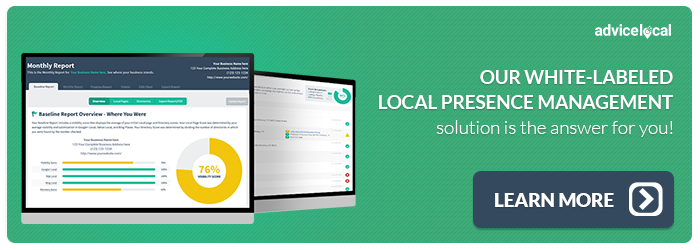Welcome back! We’ve been on a journey back to the basics of search engine optimization (SEO). It’s always good to reinforce a solid foundation so we can build something even greater on top of it. As you may know I have an affinity for local search, and since we’ve been reviewing best practices for SEO, you probably had an idea that a Local SEO series was soon to come.
Local businesses, even those attached to a greater regional or national brand, have a unique opportunity to reach their nearby target audience in search. They have the chance to convert on what Google refers to as the Micro-Moment. Immediacy often drives traffic locally; people need something and they need it now. (Learn more about Micro-Moments in this research paper.)
- 56 percent of on-the-go searches have local intent
- 82 percent of smartphone users turn to a search engine to find a local business
- 82 percent of smartphone users check their phones in-store, when deciding what to buy
These are important moments for brands, to be there, to show up and have relevant information for these varied consumer searches. Sure, there are still searches for the basics like NAP data and business hours, but consumers are now looking for more details like product information and what is in-stock at a particular location.
This doesn’t happen without a strategy and plan in place. Let’s take look at what it takes to have a solid local SEO strategy that brings in the traffic you need.
Local Search Defined
We often talk about local search engine optimization (SEO) or local search but rarely place a definition with it. As a subset of SEO, it has a geographical-based focus. To put it simply:
Local SEO is the process of obtaining visibility and gaining traffic in search results on various search engines, for a geographic area.
So what does that mean in real terms? Last week a friend was traveling to a conference and her bag, with her phone and laptop chargers, was lost at the airport. (Nightmare city, right?)
Although she was afraid she was out of luck, with the last bit of juice in her phone she was able to conduct a search for electronics stores near the airport and her hotel. (This is a Micro-Moment.)
She caught a cab and was able to find exactly what she needed because that store prioritized being found. While there, she even picked up a few other items, meaning the store met her need and was able to gain additional sales because of that.
This is the essence of local search.
Be Found in Search Around Town
Digital marketing, especially SEO, can be downright overwhelming. There are so many questions that come up.
- Why do my locations seem to have multiple listings?
- Why are my review scores all over the place?
- I thought we were already optimized, what happened?
- Will social media help me?
- What’s the ROI on all of this anyway, and how can I know for sure?
I like to keep things simple, so below is the highlight reel for a business to get found in local search results.
5 Must-Haves for Getting Found in Local Search
- Maintain Accurate Business Listings Online. The Internet is full of business listings services, which are similar to the old school Yellow Pages. These include services, shops, companies and facilities within a given geographic area. It’s quite possible your business is already listed without your knowledge. This is a good time to take control of your online data and how your company is presented on these third-party websites. Many of these sites are eager for you to have you claim your listing, which more often than not, is a free process.
- Manage Your Reputation on Review Sites. Websites like Google, Yelp and Foursquare encourage customers to leave reviews for companies they’ve done business with. These sites need to be checked often, to see how your business or businesses are currently rated. Be sure to take appropriate action, with responses to both negative and positive customer entries. Advice Local can help with this, too.
- Optimize Your Website Content. Identify keywords customers are likely to use when searching for businesses in your industry and segment. Strategically include these words and phrases in your site’s content. This, along with other SEO activities, makes it easier for algorithms to crawl your site, meaning you have a better chance at higher search placement, which makes you discoverable, by potential customers in search results.
- Utilize Social Media. Facebook, LinkedIn, Twitter and the like, offer excellent opportunities to engage with your current customers and target audiences. Build relationships on the proper social media channel, which is the site or sites frequented by those customers and prospects. Give them the information and content that keeps them coming back.
- Track Your Performance. Many good applications exist to help you track your website’s performance, sites making referrals, social media, email offers and content downloads. The great thing is, many of these are free or have lower-cost options. You also want to find ways to measure conversions; sometimes, it’s as easy as asking the question. Once you can review this data and assess how you’re doing, you’ll know what steps you need to take to get better results.
We’re Just Getting Started
I hope you gained a bit of insight into the wonderful world of local search today. Continue with us through the rest of the series and learn about online business listings, the importance of monitoring business reviews, websites that work and more.
- Local Search Made Easy: Get Listed, Get Optimized and Get Found
- Local Search Made Easy: Reputation Management and Reviews
- Local Search Made Easy: Websites that Work
- Local Search Made Easy: Enhancing a Business’ Online Presence with Social Media
Whether you have one business or are the representative for multiple, Advice Local is here to help!
What’s your favorite aspect of local search? How much success have you seen by focusing locally? I’d love to hear about it in the comments.
Be sure and come back each week for more local search news from the #QueenofLocalSEO.




